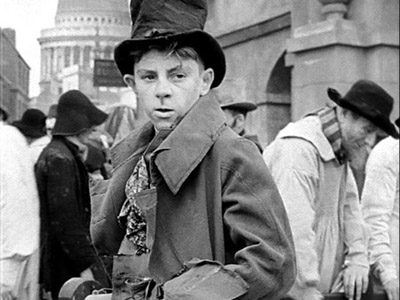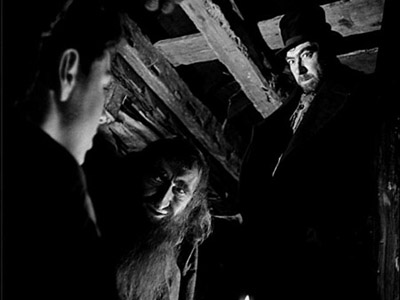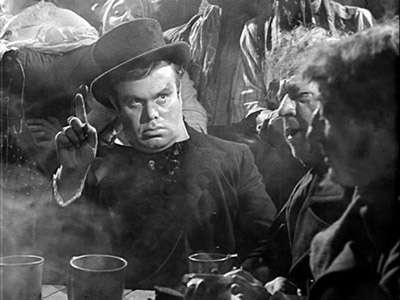Andrei Rublev, 1966, directed by Andrei Tarkovsky, written by Andrei Tarkovsky and Andrei Konchalovsky.
Here's a minor incident in Andrei Rublev that illustrates the film's moral landscape. A Russian prince is building a new house; he hires stoneworkers to do part of the construction. They finish the work on time and under budget, but the prince isn't happy; he wants the whole place redone because the colors aren't bright enough. The contractors won't do it; they have been hired for another job. As it happens, they're supposed to go work on a house for the prince's brother, where (they unwisely inform the prince), no expense is being spared, and the quality of the stone will be better. The prince shrugs his shoulders, resigns himself to being outshined by his brother, and sends them on their way.
Then he has his soldiers meet them on the road and gouge their eyes out.
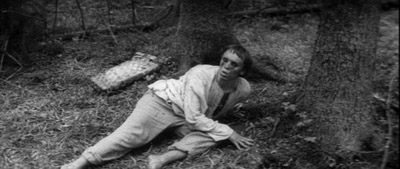
A forest filled with eyeless men screaming in pain and crawling in circles: that's the backdrop of cruelty against which Andrei Rublev operates.
The film is a fictional version of the life of Russia's greatest iconographic painter, and in many ways it's as strange as iconography itself. It's a movie about a great painter in which you never see anyone painting; the title character is usually peripheral to the action (if not entirely absent); it has not three but seven clearly delineated acts (plus a prologue and epilogue), and the first clear footage you see of one of Rublev's paintings occurs roughly three hours and twenty minutes after the film begins. That's right, three hours and twenty minutes (total running time: 205 minutes). So have some coffee ready. The movie deserves both the time and attention it demands, however. Tarkovsky raises questions about power, suffering, theology, and art in a richer fashion than any other filmmaker. I expect to have Andrei Rublev floating around in the back of my mind for a long time.
If you're not familiar with Rublev's work (I wasn't), he lived from around 1360 to 1430. Here's the one surviving painting that's entirely his own, the Old Testament Trinity (the image depicts Abraham's three guests in Genesis 18):
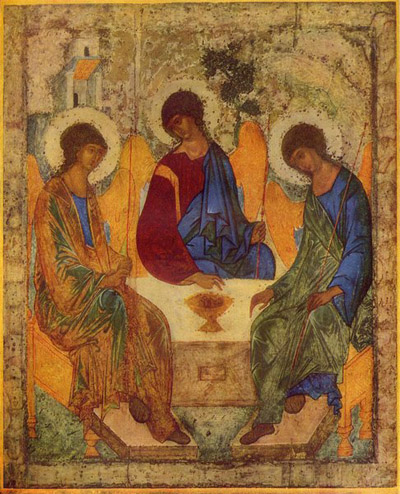
(Click for a high-res version from Wikipedia)
For me, the invention of linear perspective is a bright line between painting I really appreciate and painting that seems more mysterious than approachable. Of course, Eastern iconography isn't meant to be approachable in any sense of the word; part of the point of its strangeness is to remind the viewer that what it depicts is not the world we know, but spiritual truth. In fact, the Eastern Orthodox church had (has?) a set of very strict rules for iconography, established in 1551. The model from which these rules were drawn was the work of one Andrei Rublev. So Rublev's influence was not limited to artists independently imitating and learning from him (as is true of every other artist); his style of painting was church law.
That's all background to the movie, and honestly you don't have to know any of it to appreciate the film. Rublev's personal artistic development is at best a secondary concern; the main concern as I see it is dealing with a world in which the exercise of power, whether by God or man, is unjust and arbitrary. Again and again, Tarkovsky presents the viewer with scenes of people being punished. Sometimes we know why: a jester is arrested for singing an obscene song about a boyar (and dropping his pants). Sometimes, we have no idea: the second act opens with a monk walking across a city square as a man in the background is tied to a rack. He protests his innocence, but we never know what he's innocent of.
Tarkovsky has an eye for the way cruelty and power are exercised. You can see it in the bored faces of the guards in the first act as they smash the jester's face into a tree, or the false bonhomie a Tartar warlord maintains as he marches toward a city he will utterly destroy. Tarkovsky is also keenly aware of the ways the powerless console themselves, from Theophanes the Greek's nihilistic wish for apocalypse ("We'll burn like candles") to Rublev's withdrawal into asceticism. But then, growing up under Stalin would give anyone an unusually strong grasp of the way the powerful use cruelty, terror, and pain.
For me, at least, it was impossible to watch this movie without thinking of Stalin. Tarkovsky was born in 1932; for the first twenty years of his life, he knew no other political leader. Martin Amis has written that Stalin's cruelty "was not medieval so much as ancient in its severity." Well, Andrei Rublev has plenty of medievally severe cruelty. Some of it is difficult to watch. And in the Russia that Tarkovsky grew up in, medievally severe cruelty simply wasn't severe enough. Medieval severity just wouldn't do. It should be no wonder that what could have been a traditional biopic became a meditation on the artist's role in an unjust society.
All this makes the movie sound at once more cruel and faster paced than it really is. Art is part of Rublev's story, and it's not entirely a story of suffering. You can see Rublev struggle from beginning to end with a question which must have had personal significance for Tarkovsky: does an artist have a responsibility to the powerless? In the first act, Rublev says nothing as the jester is taken away; in the third, he stumbles onto a pagan celebration and later says nothing as soldiers round up the revelers. He is hired by the same prince that gouges his coworker's eyes out, and again does nothing. When he finally does act, killing a Tartar during the sack of Vladimir, he is wracked with guilt and retreats entirely from the world, ceasing his painting and taking a vow of silence which he does not break for years. The question of when artists should bear witness, when they should intervene, and when they must forgive hangs over Rublev's life from beginning to end. It's not a great stretch of the imagination to imagine that it also hung over Tarkovsky's.
The cinematography in this film is spectacular. Tarkovsky and his D.P. Vadim Yusov have a genius for camera movement, and there are shots in this film that rival Scorcese or Welles at their most elaborate. The best example of this is a shot toward the end, during a sequence in which a cathedral bell is about to be raised from the hole in which it has just been cast. This is one continuous shot, broken down into frames, and worth going over in its entirety.
The camera begins rougly above the bell, looking at the line of cables that will be used to pull it from its hole:

The camera follows the cables up, revealing the walls of a city in the distance and putting a procession on horseback crossing a bridge toward the center (this is the prince who has commissioned the bell, leading an Italian ambassador up to hear the bell ring for the first time, but we don't know this yet):

We follow their path across the bridge and up into the middle distance:

The structure of a building appears in the left part of the frame and the camera leaves the procession to track along the roofbeams...:
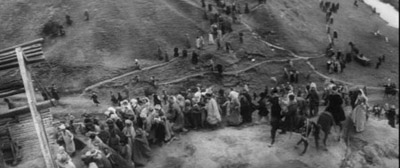
...Revealing that the building is, in fact, the forge where the metal for the bell was fired (we've seen it in an earlier scene).
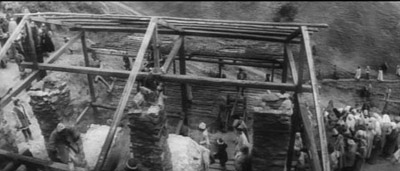
Tracking the beams all the way across reveals a group of men gathered around a winch further left:
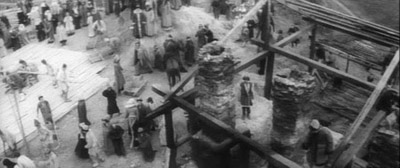
The camera centers on the winch...

...and then begins a vertical pan along the rope they are pulling, until a man's head appears very near the foreground:
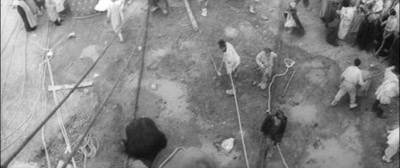
He's standing on a wooden structure directly below the camera; one of its beams cuts straight across the frame as we track back:

Until we are looking down into the pit the frame encloses, and can see the bell far below us, with all the ropes attached.
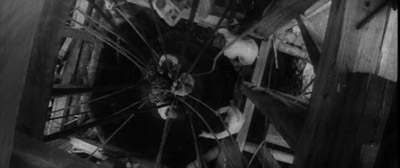
I love two things about this shot;. First, its scale varies incredibly rapidly. The city walls must be a mile away; the man on the bell structure is a few feet from the lens. You can see kind of the same thing in some of Peter Jackson's best work on Lord of the Rings. The other thing about this sequence is that the camera's movement seems to be motivated more by geometry than by anything human. If you look at the Copacabana shot in Goodfellas, part of what makes it so inviting is the way the camera tails Ray Liotta, like you're someone who also gets to go into the back entrance to the Copa (the same holds for all the shots that ripped it off after then). This is different; the camera seems to pick up a geometric shape in the image (the lines of the cables, or the roofbeams, or the bridge) and tracks it until a more interesting line to follow appears. It's spectacular but not intimate, not human. Tarkovsky's detatchment here reminds me of nothing so much as iconography.
Randoms:
- The eye-gouging is by no means the hardest thing to watch in this movie. The sack of Vladimir in the second part is nearly impossible to watch. It seems to be based at least in part on Guernica, and has many shots that are truly horrifying (a cow smashing around a stable in terror, its skin on fire; a horse falling down a flight of stairs, struggling to its feet, and collapsing backwards as its broken legs convulse; blood jetting from a young boy's neck). It ends with a villager (a priest?) being tortured to death inside a church. He asks to be allowed to kiss a cross before dying; his tormentors agree, then melt a silver cross down, hold his mouth open, and pour several cups of molten metal down his throat. The gurgling sound he makes has already appeared in one of my nightmares.
- Vlada Petric quotes Tarkovsky in one of the extra features as saying that what makes a film epic is when each character is his own center of the movie. I think this is a valuable point. When I'm working on an outline for a screenplay, I know I'm on the right track when I can tell the story from the perspective of any of the main characters and get a coherent movie with a beginning, middle, and end. Andrei Rublev takes this to a real extreme; Rublev is arguably not the main character in almost every act of the movie. But from the perspective of any character the film stays with during an act, there's a real story, beginning, middle, and end.
- I went all the way through that one shot of the bell and I didn't even mention what was, for me, the most beautiful sequence in the movie: Andrei Rublev's vision of the crucifixion. It's pretty traditional, with one exception. It's in Russia in the middle of winter. One still from this hauntingly beautiful scene:
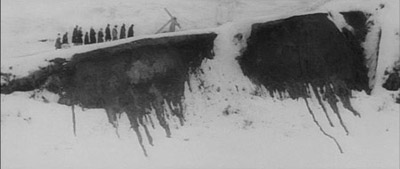
- The release history of this film is troubled; for some reason, the Soviets didn't want something that could be read as critical of the Soviet experiment on the market. For an example of why they didn't like it, try to read this description of the Pharisees (from the voiceover to the crucifixion scene) and not think of the Russian Revolution:
The Pharisees were masters of deceit, educated. They had studied to gain power, to take advantage of the people's ignorance. We must remind people more often that they are people. Russians, of the same blood, of the same land.
As a result of passages like these, the film was shelved upon its completion in 1966 and not publically shown until the 1969 Cannes Film Festival (when it was shown semi-illegally, over protests from the Soviet Embassy). This gap between completion and screening is why the IMDB lists the film as being from 1969, the Criterion Collection from 1966.
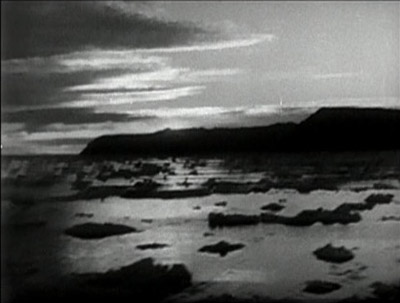
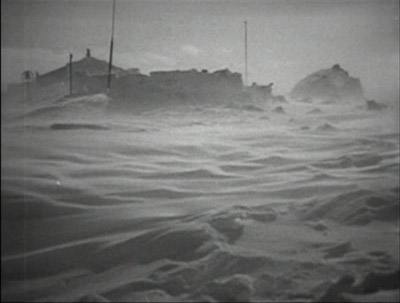
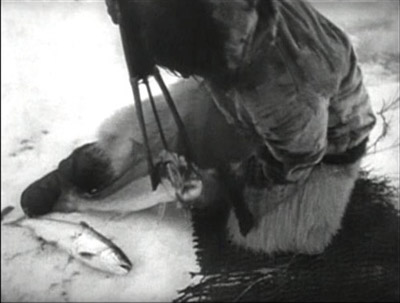
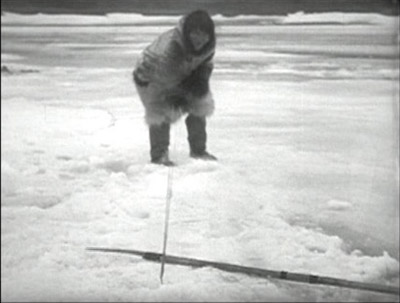


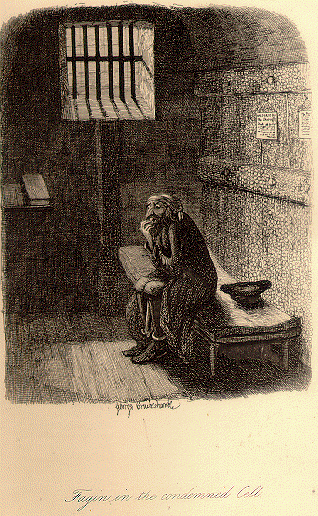

 Competence, thy name is Bumble!
Competence, thy name is Bumble!